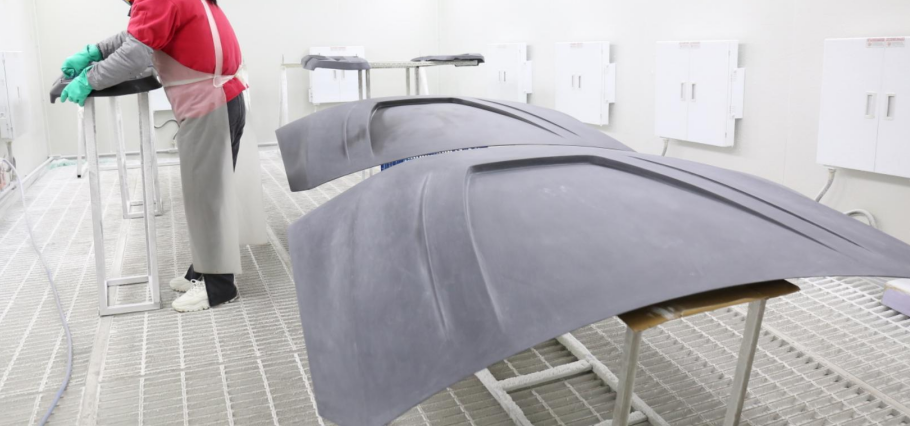Shenzhen Alu Rapid Prototype Precision Co., Ltd.
Let's share life
Tips for making carbon fiber molds
- 2025-05-31 11:48:05

Creating carbon fiber molds requires precision, patience, and the right materials and techniques to ensure high-quality, durable results. Here are practical tips for making carbon fiber molds:
1. Design and Planning
Understand Your Part: Start with a clear design of the final carbon fiber part. Consider shape, size, and complexity to design a mold that matches your needs.
Material Selection for the Plug: The plug (or pattern) is the master shape from which the mold is made. Use materials like foam, wood, MDF, or machined aluminum for the plug, depending on durability and precision needs. For high-quality finishes, choose a smooth, stable material like aluminum or high-density foam.
Draft Angles: Incorporate slight angles (1-5 degrees) on vertical surfaces of the plug to ease mold release.
Tolerances: Account for shrinkage (typically 0.5-1%) and the thickness of the carbon fiber layup when designing the plug.
2. Plug Preparation
Surface Finish: Ensure the plug has a flawless surface, as the mold will replicate every detail. Sand it progressively (e.g., 400 to 1200 grit) for a smooth finish.
Sealing: Seal porous plug materials (e.g., wood or foam) with epoxy or a sealing primer to prevent resin absorption. Apply multiple thin coats, sanding between layers.
Release Agent: Apply a high-quality mold release agent (e.g., wax, PVA, or chemical release like Frekote) to the plug. Follow manufacturer instructions—typically 3-5 coats of wax, buffed, or a sprayed release for a non-stick surface.
3. Material Selection for the Mold
Resin: Use epoxy resin for molds due to its strength, low shrinkage, and heat resistance (better than polyester or vinyl ester). Choose a high-temperature epoxy if the mold will be used for curing carbon fiber at elevated temperatures (e.g., 250°F/120°C or higher).
Reinforcement: Select fiberglass, carbon fiber, or a hybrid for the mold. Fiberglass is cost-effective and durable for low to medium production runs; carbon fiber is stiffer and ideal for high-precision or high-heat molds.
Gel Coat: Start with a tooling gel coat (epoxy-based) for a durable, smooth mold surface. Look for high-temperature, chemical-resistant options.
4. Layup Process
Layering: Apply a thin layer of gel coat (0.5-1 mm) to the plug and let it cure partially (tacky stage). Then, lay up the first layer of reinforcement (e.g., lightweight fiberglass or carbon fiber cloth) with resin. Use a brush or roller to wet out the fabric, removing air bubbles.
Multiple Layers: Add 3-6 layers of reinforcement, depending on mold size and strength needs. Stagger seams between layers to avoid weak points. Alternate fabric types (e.g., woven and mat) for balanced strength and stiffness.
Vacuum Bagging: For best results, use vacuum bagging to compress layers, remove air, and ensure a dense, strong mold. Seal the wet layup in a vacuum bag, apply vacuum pressure (e.g., 25-29 inHg), and cure per resin instructions.
Cure Time: Follow the resin’s cure schedule—typically 24-48 hours at room temperature, or use an oven for post-curing (e.g., 120°F/50°C for 4-8 hours) to boost strength and heat resistance.
5. Mold Release and Finishing
Demolding: Once cured, gently separate the mold from the plug. Use plastic wedges or compressed air to avoid damaging the mold or plug. Work slowly to prevent cracks.
Sanding and Polishing: Sand the mold surface lightly (600-1200 grit) to remove imperfections, then polish with a compound for a glossy, smooth finish that aids part release.
Reinforcement: For large or complex molds, add external supports (e.g., a wooden or metal frame) to prevent flexing or warping during use.
6. Tips for Success
Temperature Control: Work in a controlled environment (e.g., 70-75°F/21-24°C) to ensure consistent resin curing. Avoid high humidity, which can affect epoxy.
Safety: Wear gloves, safety glasses, and a respirator when handling resin, carbon fiber, or sanding dust. Work in a well-ventilated area.
Thickness: Aim for a mold thickness of 3-6 mm for small parts, thicker (8-10 mm) for larger ones to ensure rigidity.
Test Run: Before mass production, make a test part to check mold accuracy, release properties, and surface finish.
Maintenance: After each use, clean the mold with a mild solvent (e.g., acetone, if compatible) and reapply release agent to prolong mold life.
7. Tools and Equipment
Essentials: Brushes, rollers, mixing cups, scales for precise resin mixing, vacuum pump and bag, sandpaper, and release agents.
Optional: CNC machine for precise plug creation, oven for post-curing, and a spray gun for even gel coat application.
8. Common Pitfalls to Avoid
Air Bubbles: Roll or vacuum out air pockets during layup to prevent weak spots or surface defects.
Improper Mixing: Follow resin-to-hardener ratios exactly (e.g., 2:1 or 100:30 by weight/volume) to avoid uncured or brittle molds.
Rushing: Allow full cure time; premature demolding can warp or damage the mold.
